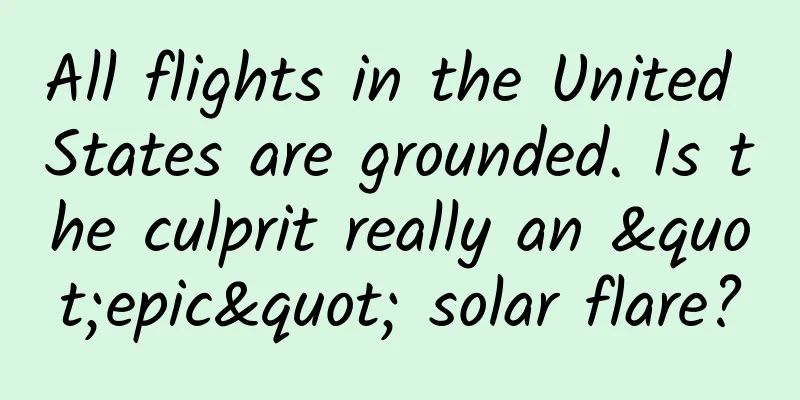All flights in the United States are grounded. Is the culprit really an "epic" solar flare?

|
2023 has arrived, and everyone is gradually getting back to their active and lively state. The sun seems to be unable to bear the loneliness and joins in the fun: on January 6, January 9, and January 10, Beijing time, three strong flares broke out on the sun. Later, on January 11, Eastern Time, the US civil aviation transportation was paralyzed and all flights in the United States were grounded. Some media outlets linked the solar activity during this period to the suspension of flights in the United States, saying that these "epic" solar flares caused the geomagnetic storms that led to the suspension of flights across the United States. Extreme ultraviolet observation image of the X1.9 flare on January 9. The flash on the left is the flare explosion. (Image source: NASA) But is this really the case? The simple and direct answer is: the recent solar flares are not the culprit for the suspension of US flights, and these flares are far from "epic", but solar eruptions including solar flares can indeed cause impacts on civil aviation flights on specific routes. 01 What is the reason for the suspension of US flights? According to the news released on the website of the Federal Aviation Administration (FAA) regarding the grounding incident, the reason for the collective grounding of flights across the United States was the failure of the NOTAM (NOtice To Air Missions) system for issuing navigation notices. Before and during the flight, pilots and various departments related to flight operations must use this system to obtain key information related to flight safety and efficiency. According to the preliminary investigation conclusion of the FAA, the failure of the NOTAM system was caused by a bug in itself and had nothing to do with the solar flare. The FAA issued a statement regarding the flight suspension, stating that the failure of the NOTAM system may be due to a problem with its own database file. (Image source: FAA) 02 Is it really an "epic" solar flare? To understand whether the three recent flares are "epic", we need to look at the level of the flares. Flares are localized explosions of sudden radiation on the sun. The flare level is determined by the maximum value of the soft X-ray intensity (strictly speaking, "flux", which is not explained here) released by the flare. First, we assign flares from weak to strong into several grades such as A, B, C, M, and X, and then determine the numerical value after the letter based on the specific intensity of a flare event. We can simply understand the letter as the "grade" of the flare, and the number after the letter as the "score" of the flare in the grade. The three flares that have erupted in January 2023 were X1.2, X1.9 and X1.0 respectively. They are indeed the strongest X-level in the flare family, but there is still a big gap from the "epic" level. The strongest flare ever recorded was the X28-level flare that erupted on November 4, 2003. The X28 rating was not derived from accurate measurements, because the intensity of the flare exceeded the range of the measuring equipment on the satellite at the time, and the actual level may be higher than X28. The "score line" of the 15 strongest flares in history is also X9.0, which is much higher than the intensity of the flares in January 2023. Therefore, to put it in an analogy, the several X-class flares in January 2023 are like a person about 1.8 meters tall in the crowd. Although they can be called tall, they are not as tall as Yao Ming and cannot be called "epic". Judging from the actual impact on the earth, the impact of these flares on the earth is mainly concentrated on shortwave communication anomalies caused by changes in the ionosphere. After the X1.9 flare erupted, the US Space Weather Prediction Center issued an R3-level warning for the quality of high-frequency radio communications near the earth. The agency divides radio communication warnings into 5 levels, with R3 at the mid-range level, and this level of warning is issued an average of 175 times during the 11-year solar activity cycle. However, the high-energy particle environment near the earth has not changed much, and there was only one weak geomagnetic storm in the first half of January 2023. All in all, the impact of these flares on the space environment near the earth is relatively limited. At the same time, solar flares themselves cannot directly induce geomagnetic storms. Although solar flares and another solar eruption phenomenon, coronal mass ejections (CMEs), often appear in pairs, just as lightning cannot wet the earth, but raindrops falling from the sky are what nourish all things, strong geomagnetic storms are usually caused by coronal mass ejections, not solar flares. Image of a coronal mass ejection in a coronagraph. Coronal mass ejections and solar flares often occur together, and the eruption process may be related, but they are not the same phenomenon. (Image source: NASA) 03 What impact do solar flares have on civil aviation? So, after ruling out the direct link between this solar flare and the flight suspension, can the civil aviation industry rest easy about the impact of solar flares? The answer is no. When flying from North America to East Asia, taking into account the shortest path on the sphere and the direction of atmospheric circulation, it is more economical and efficient to use the route over the Arctic than to cross the Pacific Ocean. Airlines can save fuel costs and save flight time for crew members and passengers. For example, the route from Boston to Hong Kong can save 138 minutes of flight time and $33,000 in flight costs each time it is used. However, from late October to early November 2003, a series of strong solar eruptions, including the strongest X28-class flare in history, made some of the Arctic routes unusable. The FAA required airlines to choose lower-latitude routes to continue flights, resulting in increased fuel consumption and flight time. Polar air routes from October to November 2003. Due to the decline in the reliability of HF radio communications, flights that originally flew via the Polar 3 route were required to switch to Polar 4 or even lower latitude routes. (Image source: NOAA) The culprit for the route disruption is the interruption of polar high-frequency (HF) radio communications. Due to the sparse land and uninhabited Arctic region, it is impossible to deploy very high frequency (VHF) radio transceivers commonly used for air traffic control along the route, and the only way is to rely on the HF band with a longer transmission distance. At the top of the Earth's atmosphere, there is a layer called the "ionosphere." The quality of HF radio communications is directly controlled by the ionosphere. When a solar flare causes a drastic change in the ionosphere, the HF band that could originally be used for long-distance transmission is no longer available, and air traffic controllers cannot effectively direct polar air traffic, so some polar routes have to be suspended. In areas with lower latitudes, although HF radio transmissions during transoceanic flights are also affected, some communications can still be maintained by relying on geostationary orbit communication satellites, and the Arctic is a blind spot for geostationary orbit communication satellites. Radiation warning area from October to November 2003, the area is marked in red. The civil aviation management department recommends that flights in this area lower their cruising altitude to reduce the radiation dose received. (Image source: NOAA) Even if HF communications in the Arctic can be restored, radiation is a risk that needs to be considered for polar flights. The polar regions are the areas where the radiation effects of solar activity affect civil aviation the most. Of course, if you don't travel between North America and East Asia several times a week, there is no need to worry about it. During the period of relatively calm solar activity, the radiation dose received for a single flight across the polar regions is between 0.1-0.2mSV. The upper limit of radiation dose received during annual flight recommended by relevant agencies is 1mSV. However, if solar activity is unusually intense, you should pay attention to the radiation situation at this time. A truly "epic" solar flare broke out in 1859. If the same event happened now, the radiation received by a single polar flight could be as high as 20mSV. If you are still flying in the polar regions at this time, it will pose a health risk to passengers and crew members themselves. Of course, space weather monitoring and forecasting agencies in various countries are also keeping a close eye on the "aviation radiation" situation. From October to November 2023, relevant agencies issued a notice recommending that long-distance flights flying above 35 degrees latitude reduce the cruising altitude from 40,000 feet to 36,000 feet. Although this will also increase fuel consumption, it can make better use of the radiation shielding effect of the atmosphere to protect the health of passengers and crew members. Solar activity has an 11-year cycle. As the sun gradually awakens from the "sleep" of the minimum period at the end of 2019 and gradually moves towards the maximum period in 2024-2025, there will be more and more solar activities in the next few years, which may have an impact on all aspects of the earth. In today's world of advanced Internet communication, some reports exaggerate and interpret news facts in an unrealistic way in order to increase their own attention. It is recommended that you pay more attention to information released by mainstream media and authoritative channels, such as the Science Popularization China account. References: 1. “Weekly Review” and monitoring data released by the Space Environment Forecast Center of the Chinese Academy of Sciences, http://www.sepc.ac.cn/. 2. NOAA, 2004, Service Assessment: Intense Space Weather Storms October 19 – November 07, 2003 3. NOAA, 2004, Technical Memorandum OAR SEC-88, HALLOWEEN SPACE WEATHER STORMS OF 2003 Produced by: Science Popularization China Author: Li Huichao Harbin Institute of Technology (Shenzhen) Producer: China Science Expo |
<<: Special: 30 pictures, full of orange
Recommend
Advantages and disadvantages of 8 major mainstream self-media platforms and operational suggestions
This article will share with you the advantages a...
Southwest Associated University Study Diary - Fan Deng Reading
Southwest Associated University Study Diary - Fan...
Oops, I squinted! Is it over after I “squinted”? Where did the foreign object that got into my eye go…
Autumn is here and the wind is getting cooler. It...
The main character of the starship's first flight was replaced. What is the strength of the new combination of Raptor configuration?
The starship's first flight changes the prota...
How to increase website user activity by attracting new users and promoting activation
User activity is an eternal pain in the hearts of...
Testin enters crowd testing, launching the world's first professional mobile app crowd testing platform
Testin, a third-party mobile application and game...
How to choose keywords for APP promotion? Come quickly!
Studies have shown that in app stores, 65%-70% of...
Looking back at the 2021 Zhuhai Air Show, we can get a glimpse of the future air combat mode from the Rainbow series of unmanned combat systems
The 2021 Zhuhai Air Show has come to an end. Comp...
3 Steps to User Growth Strategy
John has written about some methods of fission be...
How does the popular "dopamine outfit" heal your and my mood?
The new favorite in the fashion circle that has b...
Case analysis: How to increase user growth?
During the survey, we found that “growth means” i...
Pure milk was found to contain propylene glycol and failed to meet the standards! Can we still drink milk with confidence?
On June 30, the term "Xinjiang Maiqun pure m...
Frequent purchase of new energy vehicle parts means Huawei is planning to build cars? Huawei officially announced: No plans!
There have been media reports recently that Huawe...
User Operation: How to plan a user portrait system?
The term user portrait is very popular, but there...
The seemingly ordinary "little light bulb" is actually an amazing "big technology"
Produced by: Science Popularization China Author:...









